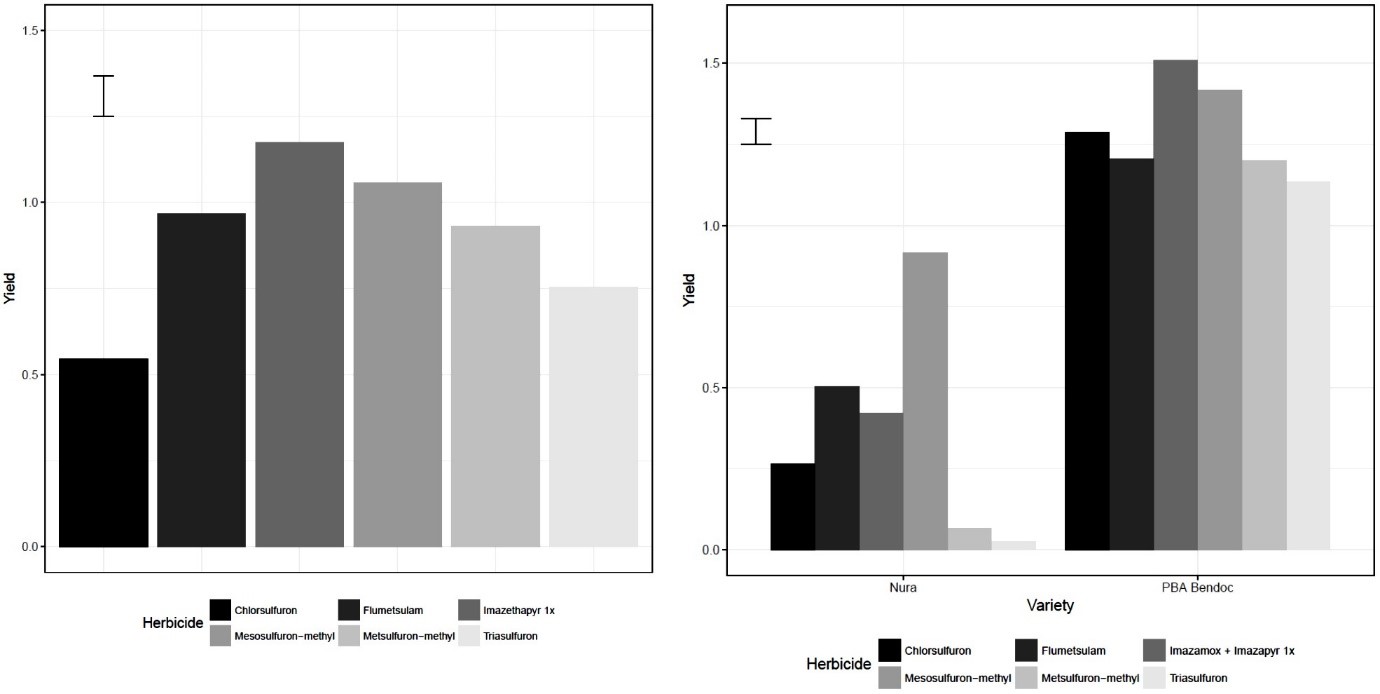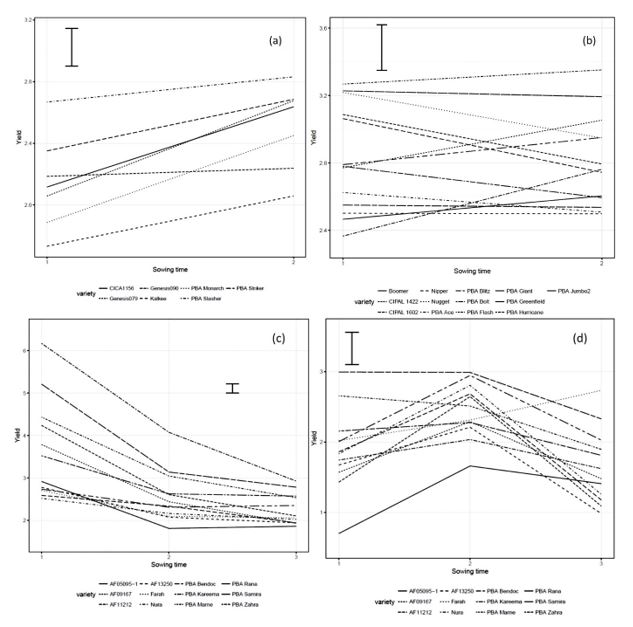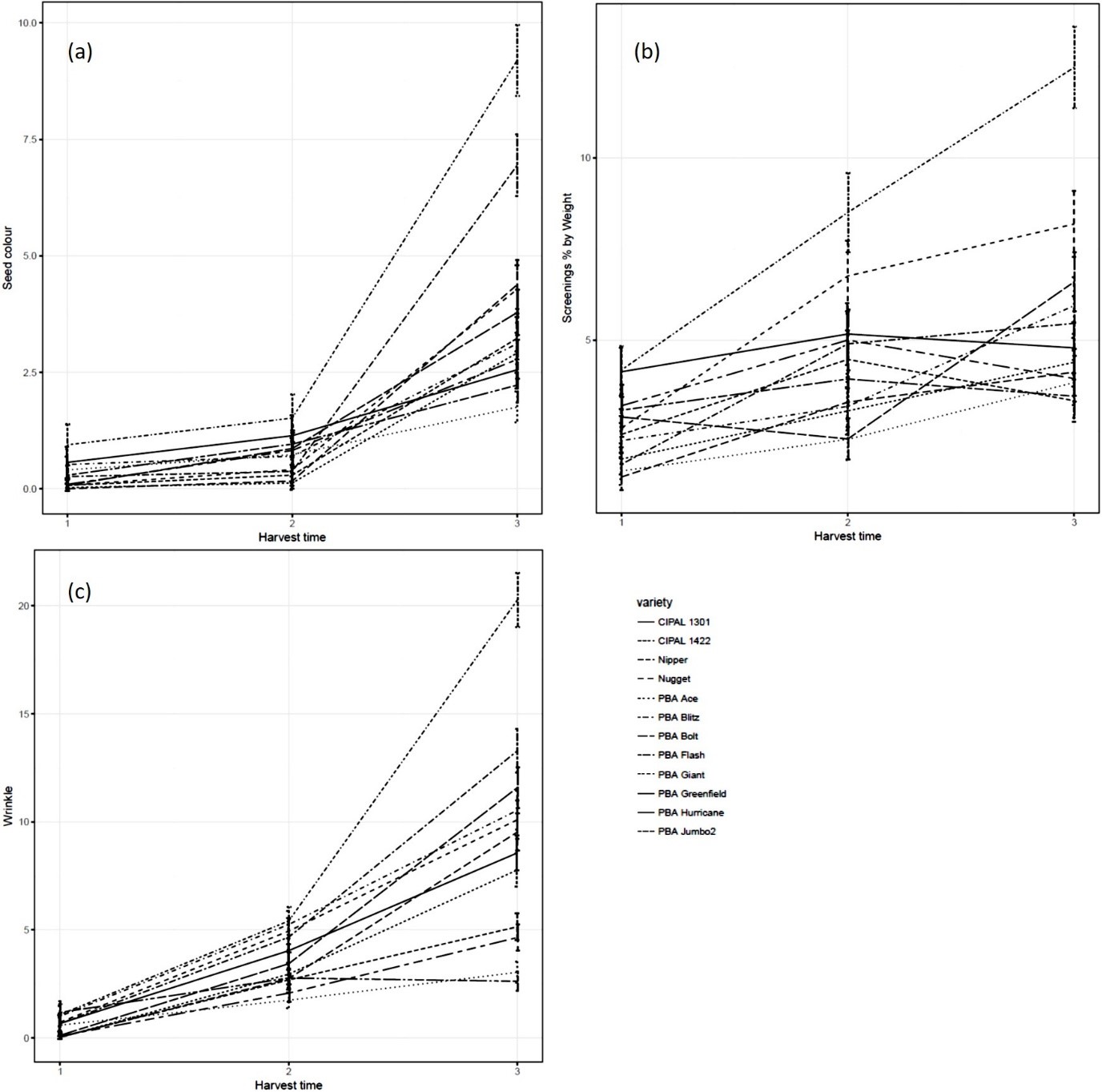South Australian pulse research update – multi-season results
Author: Penny Roberts, Christine Walela (SARDI, New Variety Agronomy), Larn McMurray (2previously with SARDI, New Variety Agronomy) and Helena Oakey (The University of Adelaide, Biometry Hub) | Date: 12 Feb 2019
Take home messages
- A newly released herbicide tolerant faba bean provides increased weed management options. A new release lentil provides another herbicide tolerant lentil variety with different agronomic characteristics. However, care still needs to be taken in relation to herbicide use, paddock selection, and herbicide permits and registrations.
- Chickpea and faba bean show a consistent trend in response to time of sowing – this information allows growers flexibility in their seeding programs.
- Timely harvest is important to meeting grain quality requirements for higher grades in lentil, however there are variety differences in response to delayed harvest.
Background
The adoption of pulse crops in South Australia (SA) has continued to increase over the past 10 years, with pulse crops making up an important part of many farming systems in all rainfall zones of SA. We continue to see rapid changes in the industry, with the release of herbicide tolerance traits in lentil and faba bean, a breakdown in disease resistance in chickpea, a lowering of disease ratings in some lentil varieties, and new chemistries released for disease management. It is important for growers to have access to the best agronomic management strategies for existing and new release varieties in order to maximise the yield potential of pulse crops. The current Southern Pulse Agronomy program has been undertaking field trials in SA and Victoria from 2015-2018 on a range of pulse crops including chickpea, faba bean, field pea, and lentil. The aim of this research has been to improve yield and yield stability of pulses in the Southern Region by focusing on a number of key areas including herbicide tolerance and weed ecology, disease management, canopy management, and harvest quality. The project has worked closely with the breeding programs to evaluate varieties prior to commercial release, allowing information to be developed on best agronomic management strategies to enable optimisation of the new varieties by growers. This paper presents some of the key results of this program. For information on disease management, refer to the 2019 Adelaide GRDC Grains Research Update paper by Sara Blake titled ’Ascochyta blight in intensive cropping of pulses’.
Results and discussion
Herbicide tolerance
In 2018, two new Group B herbicide tolerant pulses were released – the faba bean variety PBA Bendoc and the lentil variety PBA Hallmark XT. Both of these varieties have been evaluated in herbicide tolerance evaluation trials from 2015 to 2018, at sites in the Mid-North of SA. Additional trials are currently being undertaken to understand the impact of these chemistries by variety effects in different agro-ecological zones with data to become available this year.
Lentil
PBA Hallmark XT lentil was compared alongside PBA Hurrricane XT, with both varieties having the same level of response to applied herbicides, but with PBA Hallmark XT showing a higher yield across all herbicides. The work demonstrated a level of tolerance to imazethapyr when applied post emergence (4-5 node growth stage), and to sulfonylurea herbicides (SU) applied as simulated low-level residuals from a previous cereal crop (Figure 1). However, it is important to note that yield reductions did occur, particularly at the Pinery site, to some sulfonylurea herbicides applied as simulated residuals compared to the nil (Figure 1). In all years, chlorsulfuron applied as a simulated residual resulted in yield reductions ranging from 8%-52% compared to the nil. Metsulfuron-methyl and triasulfuron also reduced yields in two out of three years at Pinery, with 13%-18% and 8%-34% yield reductions, respectively.
Faba bean
PBA Bendoc faba bean was assessed alongside Nura to determine the level of tolerance of both varieties to select Group B chemistries, applied either post emergence (4-5 node growth stage) or applied as simulated low-level residuals from a previous cereal crop. PBA Bendoc demonstrated a high level of tolerance to imazamox + imazapyr herbicides when applied post emergence (4-5 node growth stage) compared to the nil. There were also higher levels of tolerance to all chemistries applied compared to Nura (Figure 1). While there were higher levels of tolerance to sulfonylurea herbicides applied as simulated residuals in PBA Bendoc compared to Nura, there was a reduction in grain yield in response to metsulfuron-methyl, flumetsulam and chlorsulfuron across multiple years compared to the nil (Figure 1). The yield reductions in metsulfuron-methyl ranged from 7%-14%, flumetsulam 14%-19%, and chlorsulfuron 8%-15%. In two of the three trials, the application of triasulfuron also resulted in a yield reduction of 8% and 18%.
The new faba bean variety provides increased weed management options to growers, while the new lentil release provides growers with a XT lentil with different agronomic characteristics. However, results indicate care still needs to be taken when considering in-crop herbicide applications, and when selecting paddocks and the potential sulfonylurea herbicides usage in the preceding crop(s). For lentil, there is a fitness penalty for growing XT lentil of 5%-10% – this needs to be considered in addition to the potential yield reductions from herbicide applications or residuals.
Importantly, current permits, product label rates, plant back periods and label directions must be adhered to. There is currently an application before the Australian Pesticides and Veterinary Medicines Authority (APVMA) seeking a permit for imazethapyr use in PBA Hallmark XT lentil and for imazamox and imazapyr use in PBA Bendoc faba bean.
Note: Herbicides used in these trials are currently unregistered and were used for experimental purposes only. The results within this document do not constitute a recommendation by the authors or organisation.

Figure 1. Grain yield (t/ha) response to the application of imazethapyr herbicide applied post emergence (4-5 node growth stage) and sulfonylurea herbicides applied as simulated low-level residuals from a previous cereal crop at Pinery in 2017. Left: Lentil varieties PBA Hurricane XT and PBA Hallmark XT (both varieties have the same tolerance pattern to herbicides – mean yield of both is shown). Right: Faba bean varieties Nura and PBA Bendoc.
Note: Herbicides used in these trials are currently unregistered and were used for experimental purposes only.
Time of sowing
Research conducted from 2015-2018 aimed to identify the effect of time of sowing on grain yield for a range of pulses in a number of environments, including the Yorke Peninsula, Mid-North, Eyre Peninsula (faba beans), and South East (faba beans) of SA. For lentil and chickpea, the first time of sowing was driven by the break in the season, with the trial generally being sown in early May. The second time of sowing was delayed by 3-4 weeks (late May-early June). Faba bean was generally dry sown in mid-April with two subsequent delays in sowing, 3-4 weeks apart.
Chickpea
There was a consistent trend for increased grain yield in chickpea, between 0 and 23%, with later sowing dates across the two environments studied (Yorke Peninsula and Mid-North), seasons and varieties (Figure 2a). These results are constant with our understanding that the grain yield of chickpea is influenced by environmental conditions, particularly temperature, during flowering and duration of reproductive period (grain filling period), and available soil moisture. Our trial work indicates early sown chickpea tends to flower in winter when temperatures are low, which can lead to flower and pod abortion. In later sown chickpea, flowering normally commences in warmer temperature conditions that are more conducive for flower and pod retention.
While the trend was for higher yield from later sowing, there was variation in the variety response to early time of sowing. For example, PBA Slasher responded better to early sowing than other varieties, with yield reductions of nil, 6% and 15% over the three years. In contrast, varieties including Genesis Kalkee, Genesis079, and PBA Monarch, show the lowest tolerance to early sowing. Knowing this information, growers can feel more confident about when to sow chickpea crops in the Mid-North and Yorke Peninsula environments. For growers looking for an earlier sowing option, PBA Slasher was the best option in these trials.
Lentil
The grain yield response in lentil to time of sowing is complex, with location and environmental limiting factors having an impact on the yield response. The broad range of agronomic characteristics in commercial lentil varieties compared to other pulses in southern Australia contributes to this complexity. An understanding of the differences in the agronomic characteristics and how they interact with the environment and potential constraints is important when making variety selection. In general, early sowing is beneficial, with the newer varieties better adapted to early sowing than traditional varieties such as Nugget. However, constraints including weeds, disease, high biomass, and frost during reproductive phases will reduce the benefits of early sowing. An example of this is Melton in 2015, where early sowing and favourable winter growing conditions resulted in high biomass production, but due to a hot and dry finish in this year, lentil plants ‘hayed off’ in spring and higher yields were achieved from a delayed sowing (Figure 2b). In contrast, in the following two years at this location, there was a stronger genotype interaction with environment and sowing date. More detailed work will commence in 2019 to better understand the yield response of lentil to variable seasonal conditions.
Faba bean
The response of faba bean to time of sowing varied between rainfall zones, with a clear response for the medium rainfall zone sites of Hart, Yeelanna and Cockaleechie. There was a consistent positive response to sowing early, with yield reductions from delaying sowing, particularly the third time of sowing, where there were yield reductions at all sites and in all seasons (Figure 2c). Some varieties including Nura, PBA Marne, and PBA Samira showed greater yield stability across all times of sowing. Therefore, if later sowing times are required to fit into the seeding program, these varieties would be better options than PBA Bendoc, PBA Rana or PBA Zahra.
In contrast, the response to delayed sowing in the higher rainfall sites, Bool Lagoon and Tarlee, was more variable, with trends noted for varieties rather than for a location. There was an increase in grain yield associated with delaying sowing for Farah and PBA Marne, while PBA Bendoc and PBA Kareema generally responded better to early sowing. In the medium rainfall zone, PBA Samira and Nura showed greater yield stability across sowing time (Figure 2d). This information will allow growers to select varieties that fit best with their seeding program, or choose varieties, such as PBA Samira and Nura, that demonstrate greater yield stability in response to sowing time.

Figure 2. Pulse response in grain yield (t/ha) to time of sowing – (a) chickpea at Pinery in 2016, (b) lentil at Melton in 2016, (c) faba bean at Hart in 2017, and (d) faba bean at Bool Lagoon in 2017.
Harvest quality
Timely harvest is essential to ensure grain quality and to meet higher grade specifications. Research on harvest timing and the impact on quality was undertaken at a range of sites over multiple seasons for lentil, chickpea, faba bean and field pea varieties.
Lentil
Delaying the harvest of lentil resulted in a reduction in all grain quality attributes including seed colour, screenings and wrinkle at all sites in all seasons (Figure 3). Many lentil varieties met the Grade 1 criteria for seed coat colour and wrinkle at the first time of harvest, approx. 10 days post-maturity. Subsequent harvest timings occurred after either a delay (e.g. 3-4 weeks) or a large rainfall event. After the first delay in harvest, most varieties were down-graded to Grade 2 lentil, and depending on the season, many varieties failed to meet Grade 2 specifications. A second delay in harvest resulted in all varieties failing to meet Grade 1 and 2 specifications, with the exception of one variety in one year. The varieties PBA Hurricane XT and PBA Ace demonstrated the highest level of tolerance to delayed harvest. PBA Hurricane XT maintained Grade 1 quality at the second time of harvest at two of five sites, while, PBA Ace met Grade 1 quality at the second time of harvest at one site and met Grade 2 quality at a further three sites. It is worth noting that PBA Jumbo 2 and Nipper were the next best performing varieties. There were consistently poor performing varieties in relation to grain quality and delayed harvest including PBA Giant, Nugget, and PBA Greenfield

Figure 3. Lentil grain quality in response to delayed harvest – (a) seed colour, (b) screening, and (c) wrinkling.
Conclusion
A key outcome of this research is an understanding of the agronomic traits of two new herbicide tolerant varieties, PBA Hallmark XT lentil and PBA Bendoc faba bean. PBA Bendoc demonstrated a higher tolerance to some imidazolinone herbicides when applied post emergence (4-5 node growth stage), and to sulfonylurea herbicides applied as simulated low-level residuals from a previous cereal crop, with PBA Hallmark XT and PBA Hurricane XT having the same tolerance pattern to the applied herbicides. However, care still needs to be taken in relation to herbicide use, paddock selection, and herbicide adherence to label registrations. The results from the time of sowing trial give growers more confidence in deciding when to sow chickpea and faba bean, and variety selection to suit their individual seeding program. Timely harvest is important in lentil to avoid reductions in grain quality resulting in down-grading – importantly there are variety differences in response to delayed harvest.
Useful resources
Acknowledgements
The research undertaken as part of this project is made possible by the significant contributions of growers through both trial cooperation and the support of the GRDC – the authors would like to thank them for their continued support. The authors would like to acknowledge the support of the technical and support staff without whom much of this work would not be possible.
Contact details
Penny Roberts
SARDI
155 Main North Road, Clare SA 5453
0436 678 982
Penny.Roberts@sa.gov.au
GRDC Project Code: DAV1706-003RMX,
Was this page helpful?
YOUR FEEDBACK
